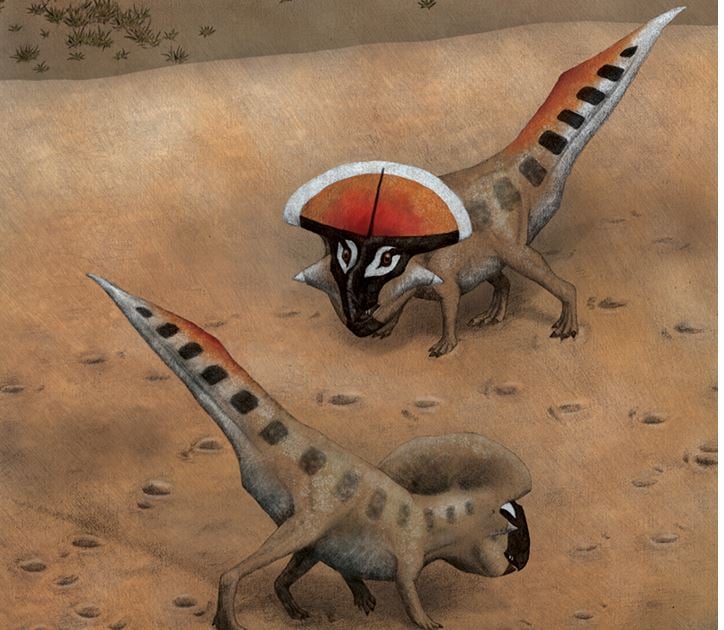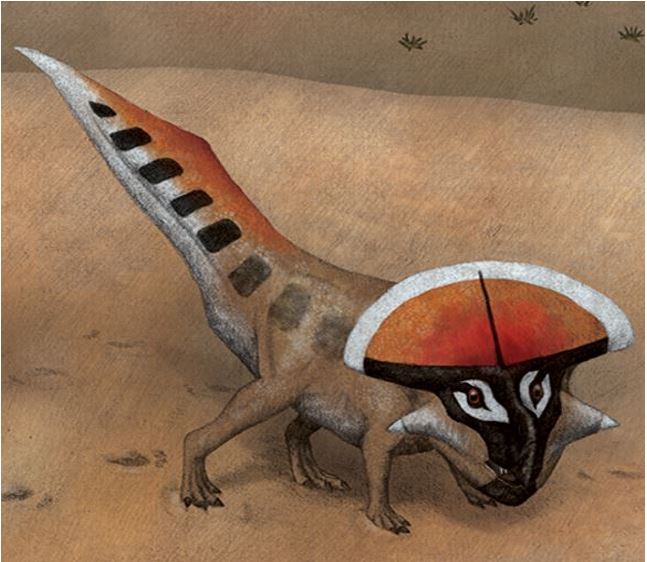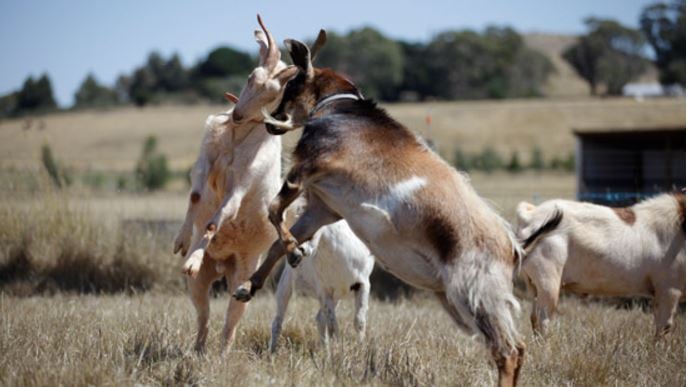The sexiest dinosaurs were the horniest too, a study carried out by scientists from Queen Mary University found. Why did some dinosaurs have elaborate horns and frills? It was to attract and secure mates, and also to drive away rival males.
Impressive ornamental structures such as head crests, horns and frills became considerably more prominent as the animals matured, fossil specimens show.
Sexual selection has influenced most of Earth’s animals for hundreds of millions of years. It is responsible for much of the behavioural and physical diversity of creatures that exist today, and which researchers believe was also a major evolutionary driver throughout history and prehistory.
 An artist’s impression of social dominance among protoceratops The sexiest animals were probably the ones with the most impressive frills and horns. (Image: palaeo-electronica.org)
An artist’s impression of social dominance among protoceratops The sexiest animals were probably the ones with the most impressive frills and horns. (Image: palaeo-electronica.org)
Sexual selection refers to the natural selection that a creature of one sex makes for certain features in individuals of the opposite sex. For example, female peacocks chose the male with the most impressive feathers as their mate.
Sexual selection also refers social dominance – competition between members of the same sex. This can include facing each other until one of them backs down, and even fighting.
According to dictionary.com, sexual selection is:
“A special type of natural selection in which the sexes acquire distinct forms either because the members of one sex choose mates with particular features or because in the competition for mates among the members of one sex only those with certain traits succeed.”
How did Protoceratops attract females?
Co-author, Dr. David Hone, a lecturer in Zoology at the School of Biological and Chemical Studies, Queen Mary University of London, and colleagues examined the fossils of protoceratops – a sheep-sized herbivorous dinosaur that measured about 1.9 metres (5.9 ft) in length.
Protoceraps existed during the Age of Reptiles – during the Late Cretaceous period, towards the end of the Mesozoic, about 86 to 71 million years ago.
The researchers, who wrote about their study and conclusions in the academic journal Palaeontologia Electronica, said that by studying the large ornamental structures on the animal’s bodies, such as horns and crests, they found that they were absent in juveniles but common and prominent in adults.
Dr. Horne explained that as the juveniles grew, they developed disproportionately larger frills – their frills grew much more rapidly than the rest of the body.
 Body ornaments among dinosaurs probably had two functions. 1. Social dominance. 2. To attract a mate. (Image: palaeo-electronica.org)
Body ornaments among dinosaurs probably had two functions. 1. Social dominance. 2. To attract a mate. (Image: palaeo-electronica.org)
Studying sexual selection in extinct animals
Studying sexual selection among animals that exist today is relatively easy – you observe them, determine what their features are, and watch how they behave.
It is not possible to watch extinct animals and learn from their features and behaviours. You have to fall back on more indirect assessments of whether a physical feature evolved because of natural selection.
One way is to see whether those traits developed more rapidly as the animal grew up – during ontogeny (from birth until maturity).
Dr. Horne said regarding dinosaurs’ features:
“Palaeontologists have long suspected that many of the strange features we see in dinosaurs were linked to sexual display and social dominance but this is very hard to show.”
“The growth pattern we see in protoceratops matches that seen for signalling structures in numerous different living species and forms a coherent pattern from very young animals right through to large adults.”
 An example of social dominance; one of the components of sexual selection. The expression “to lock horns with someone” originated in the early 1800s and refers to horned animals tussling with each other. (Image: edgarsmission.org.au)
An example of social dominance; one of the components of sexual selection. The expression “to lock horns with someone” originated in the early 1800s and refers to horned animals tussling with each other. (Image: edgarsmission.org.au)
Dr. Horne and colleagues, who studied thirty-seven different fossils, concluded that the frills were probably linked to sexual selection because they suddenly increased as the animals neared maturity.
Sexual selection’s role in shaping biodiversity
Dr. Rob Knell, Reader in Evolutionary Ecology at QMUL’s School of Biological and Chemical Science, said regarding sexual selection and biodiversity:
“Biologists are increasingly realising that sexual selection is a massively important force in shaping biodiversity both now and in the past.”
“Not only does sexual selection account for most of the stranger, prettier and more impressive features that we see in the animal kingdom, it also seems to play a part in determining how new species arise, and there is increasing evidence that it also has effects on extinction rates and on the ways by which animals are able to adapt to changing environments.”
 Protoceratops were relatively small dinosaurs that probably lived in herds.
Protoceratops were relatively small dinosaurs that probably lived in herds.
Biodiversity refers to the variety of life in the world or in a particular habitat or ecosystem.
Regarding their findings, the researchers concluded:
“These results therefore provide an important step in assessing the function of such features in the fossil record and provide confirmation that these likely evolved as a result of pressures favouring socio-sexual dominance signals.”
Citation: “Positive allometry for exaggerated structures in the ceratopsian dinosaur Protoceratops andrewsi supports socio-sexual signaling,” Hone, David W. E., Wood, Dylan, and Knell, Robert J. Palaeontologia Electronica 19.1.5A: 1-13. Published January 2016.
Video – Sexual selection among Protoceratops
Although they were plant eaters and fairly small, protoceratops had powerful beaks that were probably able to cut a human arm right off with one bite.
